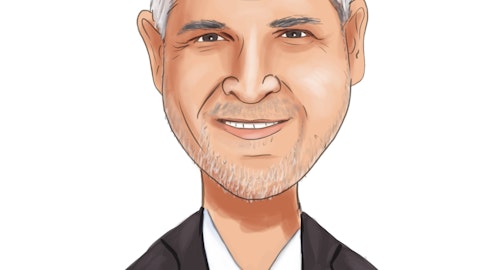UnitedHealthcare Commercial, which we announced last quarter, they have a quantity limit of four doses per RX. Now, they could write another prescription in the same month but per RX four doses. So, I think it might come down a little bit over time.
John Tucker: And I think we’re also seeing the usage in the pre-admission stage where I think you’re going to see more a higher script level. The other thing I think if you look at — Doug, if you look at our GTN at 21%, which is great, it’s a bit of a double-edged sword because we’re not paying rebates to some of the plans that want rebates. But we do anticipate soon we’ll come on formulary with a number of those and that will drive that GTN up, obviously, lower co-pays, improved adjudication time, make more access to more patients, but also probably have a shrinking effect on the number of units per script. But I think our thinking now is a little different. We think it moderates, but still stays in the 4.5 to 5 range, where I think our guidance previously had been four. We’re just seeing doctors be a little more aggressive treating patients than we originally have anticipated.
Douglas Tsao: Okay, great. That’s really helpful color. And then just in terms of how the IDNs plan to use the product, is it going to be different than sort of the individual physicians and heart failure clinics?
Steve Parsons: Yes, since an IDN is responsible for medical costs and drug costs, they take the whole burden. For them, it makes sense to use it anywhere they can to reduce the length of stay, to prevent the hospitalization in the first place. So they’ll have ability to use it everywhere and anywhere they want right away. Unlike in the rest of the world where you have to write a prescription and you have to do a prior off. These guys — they own everything. So if they want to discharge early to finish the job at home, they’re going to be able to do that.
John Tucker: I think that’s one thing, Doug, that we’ve heard a little bit more than we maybe initially anticipated. Where doctors are wanting to use this kind of post discharge when a patient is getting ready to get out, actually writing a prescription. So I think with the IDNs you even see more of that.
Douglas Tsao: Okay great. That’s really helpful color.
John Tucker: Thanks, Doug.
Operator: The next question comes from Naz Rahman with Maxim Group. Please go ahead.
Naz Rahman: Hey, everyone. Congrats on the quarter, and thanks for taking my question. Just two quick questions. The first one I have is, your number of unique prescribers seems to be increasing at a faster rate than the number of prescriptions between 2Q and 3Q. Can you comment on what that discrepancy is?
John Tucker: Yes, so again, we’ve still been focusing, especially as some of the new territories is opening new accounts. And again, these in-services take some time. And then converting those first scripts. So a lot of the new prescribers might be just writing one here early, see how it works, wait for the patient to come back before adopting it. So I think that’s what you’re seeing, but we have a number of physicians. And how it usually works, Naz, is there might be three or four and three or four nurse practitioners or maybe just one nurse practitioner for four doctors. And the nurse practitioner ends up being the writer even though the doctor might have written one the nurse practitioner tends to do most of the direct doctoring.
So I think where — we like where we’re seeing the breadth because we’re starting, especially, the start of this quarter, we’ve really seen a lot of the physicians now starting to write more consistently. October was a really strong month for us and November is off to a really good start. So I think we’re being successful in converting those doctors who have wrote one or two into doctors or their nurse practitioners who are starting to adopt the product.




